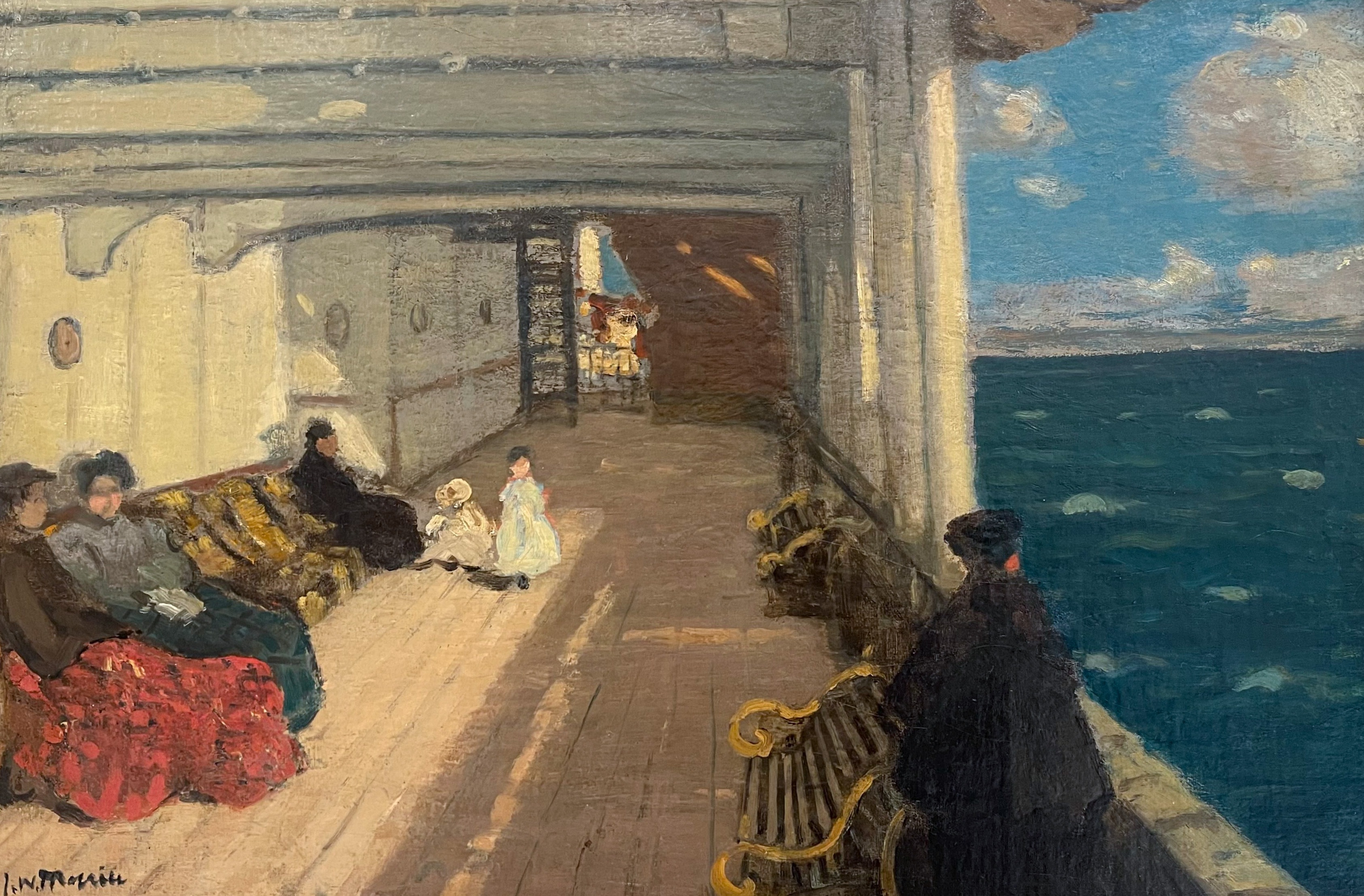‘One of [Morrice’s] most beautiful and accomplished pictures’

James Wilson Morrice (1865-1924). En pleine mer, 1903-04. Oil on canvas. 15 x 23 in (38.1 x 58.4 cm). SOLD.
- “Whistler’s dead - Let’s get drunk”, said Morrice, as he burst into Edmond Dyonnet’s studio in Montreal, on a July day in 1903 (as told to D.W. Buchanan, who did not include it in the printed version of his 1936 Biography of Morrice). On July 18th, the Montreal Gazette wrote that the American painter James McNeill Whistler had died in London the previous day. It is hard to tell if the news made Morrice happy or sad.
We know, from ship passenger lists, that he visited Canada that summer; a letter between two American painters mentions a stop in New York on his way to Montreal; and Edmund Morris, in his manuscript Diaries, writes that Morrice joined him and Maurice Cullen at Beaupré before sailing to Ile d’Orleans, to paint with William Brymner and Paul Lafleur. Strangely, no work by Morrice can yet be linked to that excursion, not even a drawing in a sketchbook... except a few drawings on board a ship including the one for the present canvas, one of his most beautiful and accomplished pictures.
The disappearance of Whistler was certainly significant for Morrice, who had fallen under his spell in late 1895; not long after, he also discovered Impressionism, and for a while, both tendencies co-existed in his art. At the 1903 Salon de la Société Nationale (Paris, April), the large Place Chateaubriand (Saint-Malo) (private collection) is Impressionist, but the very grey Effet de neige (Canada), probably Return from School (AGO) is not; and the atmospheric background of Au jardin public (Venise) (private collection) could still be seen as “whistlerian” by the reviewers. Nonetheless, Morrice was being noticed, he was now a Sociétaire (allowed six works at the Salon), and his fame was growing; after so many working trips to Saint-Malo and Venice, painting venues popular among his fellow exhibitors, Canada could offer him subjects rarely seen in Paris for the 1904 Salon.
It did not happen, and Morrice could not even find six recent canvases, adding the 1898 Fête foraine (Montmartre) (now St. Petersburg, Hermitage, purchased at the Salon by Ivan Morosov). Again the reviewers took note of his entries - among more than 1300 canvases! - but again they mostly noted his allegiance to Whistler. Fête certainly qualifies, and three others, also French subjects, share a melancholic pale palette: the large Charenton (le soir) (Fredericton, Beaverbrook AG, retitled At a Country Fair in 1924), the very atmospheric Quai des Grands-Augustins (Paris, Musée d’Orsay, bought at the Salon by the French State), and La plage (Paramé) (also Fredericton, BAG); one work, Marine, remains to be identified.
The sixth work, however, although only half the size of Charenton/Country Fair, immediately stands out with its sunny, joyous colours. And its composition! Unlike its neighbours on the Salon wall, loosely based on horizontals, En pleine mer invites us in by a bold, deep – and almost empty – triangular space, with figures, carefully placed on its edge. Vertically, the surface is divided in two spaces, two-thirds closed at left (On Shipboard, a 1960s dealer title) and one third open at right (En pleine mer, Morrice’s title, meaning “On Open Seas”). The dividing post, in fact the whole superstructure, is leaning slightly, as if the ship rolled gently: for once the artist did not adhere strictly to the grid, resulting in a more dynamic composition, with the shadows creating even more animation. In front of the white post, and in line with it, a woman in black contemplates the wide expanse of the blue ocean, the true subject of the painting; originally painted smaller, her enlarged dark presence makes her the anchor, or the pivot, of the whole composition, a visual link between the colourful deck and the almost monochrome ocean. That was all planned in the studio: she, and the little girls, are not present in the drawing (Montreal Museum of Fine Arts, Sketchbook #5 page 8).
Bright colours, a black silhouette, the soft, mellow touches used to depict the little girls – we immediately think of French painter Pierre Bonnard, while the tapestry-like depiction of the women sitting on the deckchairs, including a checkered plaid, evoke his friend Edouard Vuillard; both were contemporaries of Morrice, already making waves as part of the Nabis. They and their followers admired Gauguin, but also Japanese prints, a possible source here for the empty triangular central space, the dividing post, and the slightly elevated point of view.
As John O’Brian has demonstrated in 1982, in the Revue de l’Université de Moncton, Morrice was probably introduced to their work by the Irish painter Roderic O’Conor in late 1903 or early 1904 – precisely when he was seriously thinking about the 1904 Salon de la Société Nationale, including of course En pleine mer. O’Brian actually uses the canvas to illustrate his point, while noting some differences: Morrice’s space is deep, focusing on a patch of sky, while Vuillard’s space is usually very shallow, more intimist; and I would add that Bonnard, in a similar composition, might have placed the standing woman closer to us, cut just below the neck by the lower frame, as he did so often. Morrice does not dare go that far; a step forward, not a true break: his ocean and his sky could belong to his celebrated series of Saint-Malo beaches and regattas.
In spite of the more anecdotal English title, there is really no story here: women and little girls spending their time on the deck of an Atlantic liner, while the men are smoking in the Saloon or exercising at the gym – amenities recently added on the North Atlantic route... for those who could afford them. Morrice never travelled otherwise, and it is easy to picture this flâneur taking a late afternoon stroll on the First Class Promenade deck; of which ship? He travelled on the German steamer Lahn from Gibraltar to New York (June 8th-16th), returning on the more modern British Ionian from Montreal to Liverpool (July 25th to August 4th), but their images are too small to allow any positive identification; the sketchbook drawing is not more informative, although it concentrates on life onboard, leaving the right quarter totally blank.
In the canvas the sea is calm, time is suspended; wealthy passengers relax in peace, never disturbed by the hundreds of passengers filling the Steerage Class (Italian emigrants from Genoa and Naples on the Lahn). A perfect representation of the leisure class... The world Morrice, by birth, belonged to, although most of his artist friends would travel Second Class or even Steerage; but he was always able to maintain a perfect balance between his world and theirs. And “balance” is the word that comes to mind here: Morrice paused his ship En pleine mer, halfway between North America, where he was born, and France, where he lived. At a pivotal point in his career, finally ready to leave Whistler behind to embrace new ideas. Less than two years later, at the 1905 Salon d’Automne, he will be able to absorb some of the Fauve colours of his future friend Henri Matisse.
Copyright © Lucie Dorais, 2021




